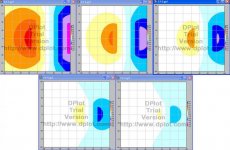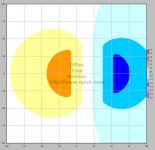There's been some speculation in discussions regarding TOI as to the effect a touch of inside english has on the throw of the object ball, or cut angle.
This image shows throw data that Dr Dave helped produce for me a few years ago. These plots represent a half ball hit, being cut to the left, hence, the left side indicates inside english and the right side shows outside english. The extremes left and right indicate maximum spinning english.
Moving up and down represents maximum follow and draw english respectively.
The colors represent comparative throw, each change of color represent about 1 inch of throw over 1 yard of travel, relative to the throw we would get with a naturally rolling shot played at medium speed.
The diagrams cover speeds 1 to 5. These are approximately equivalent to 1 table length travel up to 5 table lengths of travel. i.e. From slow to hard.
I'll make some observations regarding IE and touch of IE after posting the pic. Keep in mind that this is for a 1/2 ball hit. I also have charts for full ball, 7/8 ball, 3/4 ball, 1/4 ball and 1/8 ball hits that can be posted if people are interested.
This image shows throw data that Dr Dave helped produce for me a few years ago. These plots represent a half ball hit, being cut to the left, hence, the left side indicates inside english and the right side shows outside english. The extremes left and right indicate maximum spinning english.
Moving up and down represents maximum follow and draw english respectively.
The colors represent comparative throw, each change of color represent about 1 inch of throw over 1 yard of travel, relative to the throw we would get with a naturally rolling shot played at medium speed.
The diagrams cover speeds 1 to 5. These are approximately equivalent to 1 table length travel up to 5 table lengths of travel. i.e. From slow to hard.
I'll make some observations regarding IE and touch of IE after posting the pic. Keep in mind that this is for a 1/2 ball hit. I also have charts for full ball, 7/8 ball, 3/4 ball, 1/4 ball and 1/8 ball hits that can be posted if people are interested.
Attachments
Last edited:

